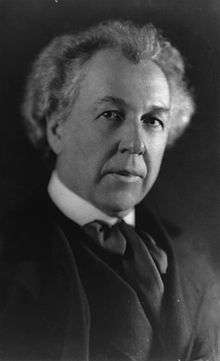Taliesin (studio)
|
Taliesin East | |
|
Taliesin III's drafting studio (left) and living quarters (right) as seen from the crown of its hill | |
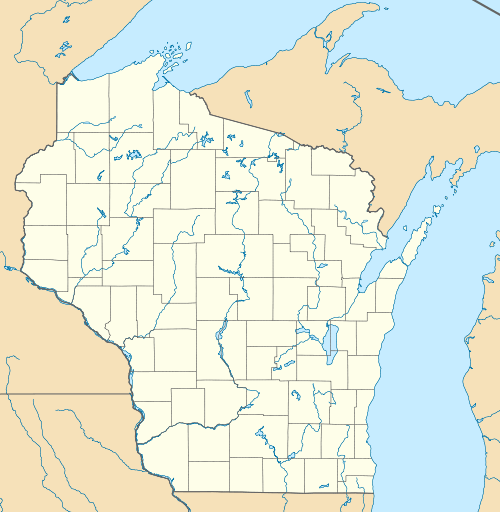  | |
| Location | south of Spring Green, in Iowa County, Wisconsin |
|---|---|
| Coordinates | 43°08′30″N 90°04′15″W / 43.14153°N 90.07091°WCoordinates: 43°08′30″N 90°04′15″W / 43.14153°N 90.07091°W |
| Built | 1911–1959 |
| Visitation | 25,000[1] (2009) |
| NRHP Reference # | 73000081[2] |
| Significant dates | |
| Added to NRHP | January 7, 1976 |
| Designated NHLD | January 7, 1976[2] |
Taliesin /ˌtæliˈɛsᵻn/, sometimes known as Taliesin East or Taliesin Spring Green after 1937, was the home and estate of American architect Frank Lloyd Wright. Located 2.5 miles (4.0 km) south of the village of Spring Green in Iowa County, Wisconsin, United States, the 600-acre (240 ha) property was developed on land that originally belonged to Wright's maternal family.
Wright designed the Taliesin structure two years after leaving his first wife and home in Oak Park, Illinois with a mistress, Mamah Borthwick. The design of the original building was consistent with the design principles of the Prairie School, emulating the flatness of the plains and the natural limestone outcroppings of Wisconsin's Driftless Area. The structure (which included an agricultural and studio wing) was completed in 1911.
Wright rebuilt the Taliesin residential wing in 1914 after a disgruntled employee set fire to the living quarters and murdered Borthwick and six others. This second version was used only sparingly by Wright as he worked on projects abroad. He returned to the house in 1922 following completion of the Imperial Hotel in Tokyo. A fire caused by electrical problems destroyed the living quarters in April 1925. The third version of the living quarters was constructed by Wright by late 1925. In 1927, financial problems caused a foreclosure on the building by the Bank of Wisconsin. Wright was able to reacquire the building with the financial help of friends and was able to reoccupy it as of November, 1928. Taliesin III was Wright's home for the rest of his life, although he began to winter at Taliesin West in Scottsdale, Arizona upon its completion in 1937. Many of Wright's acclaimed buildings were designed here, including Fallingwater, "Jacobs I" (the first Wright-designed residence of Herbert and Katherine Jacobs), the Johnson Wax Headquarters, and the Solomon R. Guggenheim Museum. Wright was also an avid collector of Asian art and used Taliesin as a storehouse and private museum.
Wright left Taliesin and the 600-acre Taliesin Estate to the Frank Lloyd Wright Foundation (founded by him and his third wife in 1940) upon his death in 1959. This organization oversaw renovations to the estate until late 1992 upon the founding of Taliesin Preservation, Inc., a nonprofit organization dedicated to preserving the building and estate in Wisconsin. Taliesin mostly operates as a museum, however it is still occupied by former students of Wright's in addition to students at the Frank Lloyd Wright School of Architecture on a seasonal basis. The property was designated a National Historic Landmark in 1976 and is being considered as part of a UNESCO World Heritage Site.
Location
Jones Valley, the Wisconsin River valley in which Taliesin sits, was formed during Pre-Illinoian glaciation. This region of North America, known as the Driftless Area, was totally surrounded by ice during Wisconsin glaciation, but the area itself was not glaciated. The result is an unusually hilly landscape with deeply carved river valleys.[3][4]
The valley, approximately 2.5 miles (4.0 km) south of the village of Spring Green, Wisconsin,[5] was originally settled by Frank Lloyd Wright's maternal grandfather, Richard Lloyd Jones, who came from Ixonia, Wisconsin with his family in 1858 to start a farm.[6] By the 1870s, Richard's sons had taken over operation of the farm, and they invited Wright work during summers as a farmhand.[7]
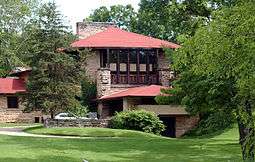
Wright's aunts Jennie and Nell began a co-educational school, Hillside Home School, in the family valley in 1887 and let Wright design the building; this was Wright's first independent commission. In 1896, Wright's aunts again commissioned Wright, this time to build a windmill. The resulting Romeo and Juliet Windmill was unorthodox but stable. In the winter of 1900, Wright compiled a portfolio of photographs he took of the surrounding area for a promotional brochure for the Hillside School. Unsatisfied with his original design for the Hillside School, Wright replaced the school in 1902 with a Prairie School design.[7] Wright later sent several of his children to receive an education at the school.[8] Wright's final commission on the farm was a house for his sister Jane Porter in 1907. Tan-Y-Deri, Welsh for "Under the Oaks", was a design based on his recent Ladies Home Journal article "A Fireproof House for $5000." The family, their ideas, religion, and ideals, greatly influenced the young Wright, who later changed his middle name from Lincoln (in honor of Abraham Lincoln) to Lloyd in deference to his mother's family.[7]
When Wright decided to construct a home in this valley, he chose the name of the Welsh bard Taliesin, whose name means "shining brow" or "radiant brow". Wright learned of the poet through Richard Hovey's Taliesin: A Masque, a story about an artist's struggle for identity.[9] The Welsh name also suited Wright's roots, as the Lloyd Joneses gave Welsh names to their properties.[10] The hill upon which Taliesin was built was a favorite from Wright's youth; he saw the house as a "shining brow" on the hill.[11][12] Although the name was originally only applied to the house, Wright later used the term to refer to the entire property. Wright and others used roman numerals to distinguish the three versions of the house.[13]
Early history

From 1898 to 1909, architect Frank Lloyd Wright lived and worked out of his home and studio in Oak Park, Illinois. In Oak Park, Wright had developed his concept of Prairie School architecture, designing houses primarily for local clients. In 1903, Wright began designing a home for Edwin Cheney, but quickly took a liking for Cheney's wife. Wright and Mamah Borthwick Cheney began an affair and separated from their spouses in 1909.[14] They met up in Florence, Italy, in February 1910, where Wright made sketches of his future studio. He was particularly inspired by Michelozzo's Villa Medici in Fiesole because it was built into a hill, had commanding views of its surroundings, and featured gardens on two levels.[15]
In 1911, the pair sought to return to the United States, but knew they could not escape scandal if they returned to Oak Park.[16] Wright saw an alternative—his family's ancestral farm near Spring Green, Wisconsin. On April 3, Wright wrote to a friend requesting money to purchase "a small house" for his mother. By the 10th, Wright's mother Anne had a signed deed for the property. By using Anne's name, Wright was able to secure the 31.5-acre (12.7 ha) property without attracting any attention to the affair.[17][18] Late in the summer, Mamah quietly moved into the property, staying with Wright's sister at Tan-Y-Deri. However, Wright and Borthwick's new property was discovered by a Chicago Examiner reporter that fall, and the affair made headlines in the Chicago Tribune on Christmas Eve.[19][20]
Taliesin I
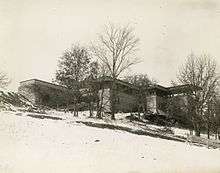
The Taliesin house had three sections: two broad portions on either end and a narrow connecting loggia.[21] Typical of a Prairie School design, the house was, as Wright described, "low, wide, and snug."[22] As with most of his houses, Wright designed the furniture.[22] One of these broad sections was used as Wright's studio and workroom. A small apartment wing juts out of this wing; the apartment may have originally been intended for Wright's mother, but was used by Wright's head draftsman.[23] Wright and Borthwick lived in the other broad portion. The one-story complex was accessed by a road leading up the hill to the rear of the building.[21] The estate gateway was on County Road C, just west of Wisconsin Road 23. Iron entry gates were flanked by limestone piers capped with planter urns.[24]
Wright chose yellow limestone for the house from a quarry of outcropping ledges on a nearby hill. Local farmers helped Wright move the stone up the Taliesin hill. Stones were laid in long, thin ledges, evoking the natural way that they were found in the quarry and across the Driftless Area.[25] Plaster for the interior walls was mixed with sienna, giving the finished product a golden hue.[26] This caused the plaster to resemble the sand on the banks of the nearby Wisconsin River.[27] The outside plaster walls were similar, but mixed with cement, resulting in a grayer color. Windows were placed so that sun could come through openings in every room at every point of the day. Wright chose not to install gutters so that icicles would form in winter.[26] Shingles on the gradually-pitched roof were designed to weather to a silver-grey color, matching the branches of nearby trees.[28] A porte-cochère was built over the main entrance of the living quarters to provide shelter for visiting automobiles.[29] The finished house measured approximately 12,000 square feet (1,100 m2) of enclosed space.[30]
Life at Taliesin
Upon moving in with Borthwick in the winter 1911, Wright resumed work on his architectural projects, but he struggled to secure commissions because of the ongoing negative publicity over his affair with Borthwick (whose husband, Edwin Cheney, maintained main custody of their son and daughter). However, Wright did produce some of his most acclaimed works during this time period, including the Midway Gardens in Chicago and the Avery Coonley Playhouse in Riverside. He also indulged his hobby for collecting Japanese art, and quickly became a renowned authority. Borthwick translated four works from Swedish difference feminist Ellen Key.[31]

In his spare time, Wright developed a fruit farm on the property with over a thousand fruit trees and bushes that he ordered from Jens Jensen in 1912. It is unknown exactly how many were planted, because part of the order was destroyed during a railroad strike. Wright requested two hundred and eighty-five apple trees planted, including one hundred McIntosh, fifty Wealthy, fifty Golden Russet, and fifty Fameuse. Among the bushes were three hundred gooseberry, two hundred blackberry, and two hundred raspberry. The property also grew pears, asparagus, rhubarb, and plums.[32] The fruit and vegetable plants were placed along the contour of the estate, which may have been done to mimic the farms he saw while in Italy.[33] Wright also dammed a creek on the property to create an artificial lake, which was stocked with fish and aquatic fowl. This water garden, probably inspired by the ones he saw in Japan, created a natural gateway to the property.[34]
In 1912, Wright designed what he called a "tea circle" in the middle of the courtyard, adjacent to the crown of the hill. This circle was heavily inspired by Jens Jensen's council circles, but also took influence from Japanese wabi-sabi landscape architecture. Unlike Jensen's circles, the rough-cut limestone tea circle was much larger and featured a pool in the center.[35] The circle featured a curved stone bench flanked with Chinese jars built during the Ming Dynasty. A large oak tree stood at the center until it blew down in a storm in 1998.[36] The tea garden also included a large plaster replica of Flower in the Crannied Wall, a statue originally designed by Richard Bock for the Susan Lawrence Dana House; the namesake poem is inscribed on its rear.[37]
Attack and fire
Julian Carlton was a 31-year-old man who came to work as a chef and servant at Taliesin for the summer. Carlton was of African American descent, ostensibly from Barbados. He was recommended to Wright by John Vogelsong, Jr., the caterer for the Midway Gardens project. Carlton and his wife Gertrude had previously served in the house of Vogelsong's parents in Chicago. Originally a genial presence on the estate, Carlton grew increasingly paranoid. He stayed up late at night with a butcher knife, looking out the window. This behavior had been noticed by Wright and Borthwick, who issued an ad in a local paper for a replacement cook. Carlton was given notice that August 15, 1914 would be his last day in their employ.[38]
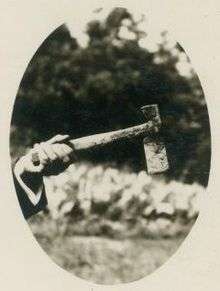
Before he left, Carlton plotted to kill the residents of Taliesin. His primary target was draftsman Emil Brodelle, who had called Carlton a "black son-of-a-bitch" on August 12 for not following an order. Brodelle and Carlton also engaged in a minor physical confrontation two days later.[38] He planned the assault, targeting the noon hour, when Borthwick, her children, and the studio personnel would be on opposite sides of the property awaiting lunch. Wright was away in Chicago completing Midway Gardens while Borthwick stayed at home with her two children, 11-year old John and 9-year-old Martha. On August 15, Carlton grabbed a shingling hatchet and began an attack. He started with the Borthwicks, who were waiting on the porch off the living room. Mamah Borthwick was killed by a single blow to the face, and her son John was slaughtered as he sat in his chair. Martha managed to flee, but was hunted down and slain in the courtyard. He then coated the bodies in gasoline and lit them on fire, setting the house ablaze.[39]
Carlton then turned his attention to the other six residents, pouring gasoline underneath the door of the far end of the residence and setting it on fire. Draftsman Herbert Fritz managed to break open a window and escape, though he broke his arm in the process. Carlton then entered the other dining room and killed Brodelle. He then hid, waiting for the other residents to try to escape. As foreman William Weston and his 13-year-old son Ernest ran through the door, Carlton attacked with the hatchet. The Westons escaped, but Ernest died from his wounds hours later. Carlton sought out the final two residents, laborer Thomas Brunker and gardener David Lindblom. Brunker and Lindblom managed to fight off Carlton and escape, but died days later from their burns and injuries. With the house empty, Carlton ran to the basement and into a fireproof furnace chamber. He brought a small vial of hydrochloric acid with him as a fallback plan in case the heat became too much for him to handle. Carlton did attempt suicide by swallowing the acid, but it failed to kill him.[39]
Lindblom and Weston alerted a neighboring farm of the attack. Weston then returned to the studio and used a garden hose to help extinguish the flames. His efforts saved the studio portion of the building and the many Wright manuscripts. Eventually, neighbors arrived to assist putting out the fire and search for survivors. Iowa County Sheriff John Williams located Carlton and arrested him. Carlton was transferred to the county jail in Dodgeville.[39] Gertrude was found in a nearby field, apparently unaware of her husband's intentions. She was dressed in travel clothes, expecting to catch a train to Chicago with Julian to seek a new job.[38]

Gertrude was released from police custody shortly after the incident. She was sent to Chicago with $7 and was never heard from again. The hydrochloric acid that Carlton ingested failed to kill him, but did badly burn his esophagus, which made it difficult for him to ingest food. Carlton was indicted on August 16 and was charged with the murder of Mamah Borthwick, the only death that was directly witnessed by a survivor. Carlton entered a not guilty plea. Forty-seven days after the fire, before the case could be heard, Carlton died of starvation in his cell.[40]
Aftermath
Bodies of the dead and injured were brought to Tan-Y-Deri, the nearby home of Wright's sister, Jane Porter. Wright returned to Taliesin that night with his son John and Edwin Cheney.[39] Cheney brought the remains of his children back to Chicago while Wright buried Mamah Borthwick on the property. Heartbroken over the loss of his lover, Wright did not mark the grave because he could not bear to be reminded of the tragedy.[41] He also did not hold a funerary service for Borthwick, although he did fund and attend services for his employees.[42] Wright struggled with the loss of Borthwick, experiencing symptoms of conversion disorder: insomnia, weight loss, and temporary blindness.[43] After a few months of recovery, aided by his sister Jane Porter, Wright moved to an apartment he rented in Chicago at 25 Cedar Street.[44] The attack also had a profound effect on Wright's design principles; biographer Robert Twombly writes that his Prairie School period ended after the loss of Borthwick.[45]
Taliesin II

Within a few months of his recovery, Wright began work on rebuilding Taliesin.[46] The new complex was mostly identical to the original building. The dam was rebuilt; Wright added an observation platform, perhaps inspired by the one he designed in Baraboo.[47] Later, he built a hydroelectric generator in an unsuccessful effort to make Taliesin completely self-sufficient. The generator was built in the style of a Japanese temple. Within only a few years, parts of the structure eroded away. It was demolished in the 1940s.[48]
While designing the new residence, Wright received a sympathetic letter from Miriam Noel, a fan of his architecture. Wright exchanged correspondence with the wealthy divorcee and met with her at his Chicago office. Wright was quickly infatuated, and the two began a relationship. By Spring 1915, Taliesin II was completed and Noel moved there with Wright. When Wright's first wife Catherine finally granted him a divorce in 1925, Wright and Miriam married. Although Wright admired Noel's erratic personality at first, her behavior (later identified as schizophrenia) led to a miserable life together at Taliesin.[49]
In the new Taliesin, Wright worked to repair his tarnished reputation. He secured a commission to design the Imperial Hotel in Tokyo, Japan; when the building was undamaged following the 1923 earthquake, Wright's reputation was restored. Although he later expanded the agricultural wing, Wright spent little time at the second Taliesin house, often living near his construction sites abroad.[50] Instead of serving as a full-time residence, Wright treated Taliesin like an art museum for his collection of Asian works.[51] Wright only truly lived at Taliesin II starting in 1922, after his work at the Imperial Hotel was completed.[52]
On April 20, 1925, Wright returned from eating dinner in the detached dining room when he noticed smoke billowing from his bedroom. By that time of night, most of the employees had returned home; only a driver and one apprentice were left in the complex. Unlike the first Taliesin fire, Wright was able to get help immediately. However, the fire quickly spread due to high winds. Despite the efforts of Wright and his neighbors to extinguish the flame, the living quarters of the second Taliesin estate were quickly destroyed. However, the workrooms where Wright kept his architectural drafts were spared.[53] According to Wright's autobiography, the fire appeared to have begun near a telephone in his bedroom. Wright also mentioned a lightning storm approaching immediately before noticing the fire. Wright scholars speculate that the storm may have caused an electrical surge through the telephone system, sparking the fire.[43]
Taliesin III

Wright was deeply in debt following the destruction of Taliesin II. Aside from debts owed on the property, his divorce from Noel forced Wright to sell much of his farm machinery and livestock. Wright was also forced to sell his prized Japanese prints at half value to pay his debts. The Bank of Wisconsin foreclosed on Taliesin in 1927 and Wright was forced to move to La Jolla, California. Shortly before the bank was to begin an auction on the property, Wright's former client Darwin Martin conceived a scheme to save the property. He formed a company called Frank Lloyd Wright Incorporated to issue stock on Wright's future earnings. Many of Wright's former clients and students purchased stock in Wright to raise $70,000. The company successfully bid on Taliesin for $40,000, returning it to Wright.

Wright returned to Taliesin in the winter of 1928 and began to rebuild the complex, which he named Taliesin III, shortly afterward. Wright's interaction with Taliesin lasted for the rest of his life, and eventually, he purchased the surrounding land, creating an estate of 593 acres (2.4 km²).[54] Some of Wright's best known buildings and most ambitious designs were created at Taliesin III. Works completed during this period include the Solomon R. Guggenheim Museum, the First Unitarian Society Meeting House, and Price Tower;[55] he designed "The Illinois", a mile-high building, there in 1956.[56] In its final form, the Taliesin III building measured 37,000 square feet (3,400 m2). All Wright buildings on the property combine for 75,000 square feet (7,000 m2), just short of 2 acres (0.81 ha), on 600 acres (240 ha) of land.[57]
Taliesin Fellowship
Wright inherited the Hillside Home School when it became insolvent in 1915. The building sat empty until 1928, when Wright conceived the idea of hosting a school there. He issued a proposal to the University of Wisconsin that would have created the Hillside Home School for the Allied Arts; however, the plan was later abandoned.[58] In 1932, the Wrights instead established the private Taliesin Fellowship, where fifty to sixty apprentices could come to Taliesin to study under the architect. Students helped him develop the estate at a time when Wright received few commissions for his work. Once he began Taliesin West, a winter home in Scottsdale, Arizona, in 1937, Wright and the fellowship "migrated" between the two homes each year.[55]
Wright did not consider the fellowship a formal school, instead viewing it as a benevolent educational institution. He also worked to ensure G.I. Bill eligibility for returning World War II veterans.[55] The town of Wyoming, Wisconsin and Wright became embroiled in a legal dispute over his claim of tax-exemption. A trial judge agreed with the town, stating that since apprentices did much of Wright's work, it was not solely a benevolent institution. Wright fought the case to the Wisconsin Supreme Court. When Wright lost the case there in 1954,[59] he threatened to abandon the estate. However, he was persuaded to stay after some friends raised $800,000 to cover the back taxes at a benefit dinner.[55][60]
Preservation
In 1940, Frank Lloyd Wright, his third wife Olgivanna, and his son-in-law William Wesley Peters formed the Frank Lloyd Wright Foundation. Upon Wright's death on April 9, 1959, ownership of the Taliesin estate in Spring Green, as well as Taliesin West, passed into the hands of the foundation. The Taliesin Fellowship continued to use the Hillside School as the Frank Lloyd Wright School of Architecture. The fellowship allowed tours of the school, but initially did not permit visitation of the house or other grounds. When the group spent two summers in Switzerland, rumors started that they were planning on selling the house to S. C. Johnson, a former Wright client. Instead, the fellowship sold a surrounding piece of land to a developer associated with the company, intending to develop a tourist complex.[61] The 3,000-acre (1,200 ha) resort included an eighteen-hole golf course, restaurant, and a visitor's center.[62]
Recognition
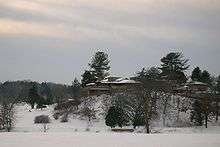
On January 7, 1976, Taliesin was recognized as a National Historic Landmark (NHL) District by the National Park Service. The nine properties contributing to the district are the landscape, Taliesin III, Hillside Home School, the Hillside Playhouse, the dam, Romeo and Juliet Windmill, Midway Farms, the pool and gardens in the courtyard, and Tan-Y-Deri. This designation also listed the property in the National Register of Historic Places.[2][63] A National Historic Landmark is a site deemed to have "exceptional value to the nation."[64]
In the late 1980s, Taliesin and Taliesin West were together nominated as a World Heritage Site, a UNESCO designation for properties with special worldwide significance. The nomination was rejected because the organization wanted to see a larger nomination with more Wright properties.[65] In 2008, the National Park Service submitted the Taliesin estate along with nine other Frank Lloyd Wright properties to a tentative list for World Heritage Status, which the National Park Service says is "a necessary first step in the process of nominating a site to the World Heritage List."[66][67] The properties are expected to first become eligible for the designation in 2016.[68]

In 1987, the National Park Service evaluated the 1,811 NHLs nationwide for historical integrity and threat of damage. Taliesin was declared a "Priority 1" NHL, a site that is "seriously damaged or imminently with such damage."[69][70] Furthermore, the site was listed by the National Trust for Historic Preservation as one of America's Most Endangered Places in 1994, citing its "water damage, erosion, foundation settlement and wood decay."[71] Taliesin Preservation, Inc. (TPI), a non-profit organization, was established in 1991 to restore Taliesin.[72]
Rehabilitation
On June 18, 1998, a severe storm damaged the estate. Heavy rains caused the drainage system to fail and a cascade of water surged over the retaining wall. This caused a mudslide, damaging the estate's foundation. Furthermore, the large oak tree at the center of the courtyard fell down on top of the house. The next year, another storm collapsed a tunnel underneath the studio wing.[73] A 1999 grant from Save America's Treasures helped defray costs to re-roof Taliesin III, to stabilize its foundation, and to connect it to a local sewage treatment plant.[74][75]
Over $11 million has been spent on the rehabilitation of Taliesin since 1998. Unfortunately, its preservation is "fraught with epic difficulties", because Wright never thought of it as a series of buildings with a long-term future. It was built by inexperienced students, without solid foundations.[76] Financing renovations has been challenging because revenue from Taliesin visitation has been lower than projected.[77]
TPI provides tours from May 1 through October 31. In April and November, the association provides only an exterior shuttle and walking tour. Because the Frank Lloyd Wright Foundation owns the property, it is inaccessible outside the confines of a tour.[78] Roughly 25,000 people visit Taliesin each year.[1]
Assessment
Architectural historian James F. O'Gorman compares Taliesin to Thomas Jefferson's Monticello, calling it "not a mere building but an entire environment in which man, architecture and nature form a harmonious whole." He continues that the building is an expression of Romanticism influence in architecture.[79] William Barillas, in an assay of the Prairie School movement, agrees with O'Gorman's assessment and calls Taliesin "the ultimate prairie house."[79] In Taliesin 1911–1914, a collection of essays about the first house, the authors and editor conclude that Taliesin was "Wright's architectural self portrait."[80] In a 2009 publication for the Thoreau Society, Naomi Uechi notes thematic similarities between the architecture of Taliesin and the concept of simplicity advocated by philosopher Henry David Thoreau.[81] Neil Levine highlighted the abstract nature of the complex, comparing it to the works of Pablo Picasso.[82]
See also
Citations
- 1 2 Verburg, Steven (July 25, 2010). "Amid an Architectural Wonder, a Family Grows". Wisconsin State Journal. Retrieved October 17, 2013.
- 1 2 3 National Park Service (2008-04-15). "National Register Information System". National Register of Historic Places. National Park Service.
- ↑ "Driftless Area National Wildlife Refuge". United States Fish and Wildlife Service. Retrieved September 24, 2013.
- ↑ Mickelson & Attig 1999, p. 93.
- ↑ Henning 2011, p. 3.
- ↑ Tauscher, Cathy; Hughes, Peter (2007). "Jenkin Lloyd Jones". Unitarian Universalist Dictionary of Biography. Unitarian Universalist History and Heritage Society. Retrieved October 6, 2014.
- 1 2 3 McCrea 2012, p. 35.
- ↑ McCrea 2012, p. 56.
- ↑ Menocal 1992, pp. 44–45.
- ↑ Wright 1943, p. 167.
- ↑ Wright 1943, p. 170.
- ↑ McCrea 2012, p. 114.
- ↑ Henning 2011, p. 5.
- ↑ McCrea 2012, p. 16.
- ↑ McCrea 2012, p. 27.
- ↑ McCrea 2012, pp. 17–19.
- ↑ McCrea 2012, p. 25.
- ↑ Henning 2011, p. 4.
- ↑ McCrea 2012, p. 57.
- ↑ Secrest 1992, p. 212.
- 1 2 McCrea 2012, p. 175.
- 1 2 Wright 1943, p. 174.
- ↑ Henning 2011, p. 24.
- ↑ Henning 2011, p. 10.
- ↑ Wright 1943, pp. 170–171.
- 1 2 Wright 1943, p. 173.
- ↑ Henning 2011, p. 17.
- ↑ Henning 2011, p. 16.
- ↑ Henning 2011, p. 14.
- ↑ Henning 2011, p. 6.
- ↑ McCrea 2012, p. 131.
- ↑ McCrea 2012, p. 176.
- ↑ McCrea 2012, p. 177.
- ↑ McCrea 2012, p. 178.
- ↑ McCrea 2012, p. 179.
- ↑ Henning 2011, p. 34.
- ↑ Henning 2011, p. 40.
- 1 2 3 McCrea 2012, p. 192.
- 1 2 3 4 McCrea 2012, pp. 188–191.
- ↑ McCrea 2012, pp. 195–196.
- ↑ McCrea 2012, p. 193.
- ↑ McCrea 2012, p. 194.
- 1 2 Wright 1943, p. 262.
- ↑ McCrea 2012, p. 198.
- ↑ Drennan 2007, p. 157.
- ↑ Drennan 2007, p. 160.
- ↑ Henning 2011, p. 68.
- ↑ Henning 2011, pp. 70–72.
- ↑ Huxtable 2004, Chapter 7.
- ↑ Smith 1997, p. 50.
- ↑ Smith 1997, p. 138.
- ↑ Packard, Korab & Hunt 1980, p. 698.
- ↑ Wright 1943, pp. 261–262.
- ↑ Hoppen 1997, pp. 59–60.
- 1 2 3 4 Matheson, Helen (April 10, 1959). "Wright: A Force of Nature". Wisconsin State Journal. p. 6. Retrieved August 6, 2014 – via Newspapers.com.

- ↑ "Sixty Years of Living Architecture: The Work of Frank Lloyd Wright (1951-1956)".
- 1 2 "Frank Lloyd Wright FAQs". Taliesin Preservation, Inc. Retrieved October 17, 2013.
- ↑ Gottlieb 2001, p. 9.
- ↑ Frank Lloyd Wright Foundation v. Wyoming, 267 Wis. 599 (Wis. 1954) (“Since Mr. Wright and his family are direct beneficiaries and the benefit to the public purely incidental, necessarily plaintiff's effort to be relieved of taxes on its property must fail because of the legal principles controlling tax exemptions”).
- ↑ "Wright's Taliesin Is Still Active". The Evening Standard. Uniontown, PA. Associated Press. June 29, 1965. p. 3 – via Newspapers.com.

- ↑ Van Goethem, Larry (July 15, 1967). "Taliesin East--a Living Symbol of Frank Lloyd Wright's Philosophy". Janesville Daily Gazette. Janesville, WI. p. 1. Retrieved August 14, 2014 – via Newspapers.com.

- ↑ "Spring Green Recreational Plan Unveiled". The Daily Telegram. Eau Claire, WI. United Press International. July 18, 1966. p. 11. Retrieved August 14, 2014 – via Newspapers.com.

- ↑ Carolyn Pitts, Architectural Historian, National Park Service (July 29, 1975). "Taliesin East – Nomination Form" (PDF). National Register of Historic Places. Retrieved October 6, 2014.
- ↑ Code of Federal Regulations: Parks, Forests, and Public Property (PDF), United States Government Printing Office, p. 301, retrieved October 17, 2013
- ↑ Allsopp, Phil (Fall 2008). "Preservation, Maintenance Key Funding Priorities for Capital Campaign". Frank Lloyd Wright Quarterly. 19 (4).
- ↑ "New US World Heritage Tentative List". National Park Service. Retrieved 2012-08-15.
- ↑ "Tentative List: Frank Lloyd Wright Buildings". UNESCO. Retrieved October 17, 2013.
- ↑ Bergin, Mary (June 27, 2014). "The Wright stuff: Architect's buildings move up on world list". The Post-Crescent. Appleton, WI. Retrieved August 14, 2014.
- ↑ Damaged and Threatened National Historic Landmarks, 1987 (PDF), National Park Service, 1987, retrieved October 18, 2013
- ↑ "Preservation". Taliesin Preservation, Inc. Retrieved October 18, 2013.
- ↑ "11 Most Endangered Historic Places: Frank Lloyd Wright's Taliesin". Retrieved October 18, 2013.
- ↑ Welcome to Taliesin Preservation, Inc
- ↑ Gould, Whitney (October 15, 1999). "Rebuilding the Wright House". The Salina Journal. Salina, KS. Retrieved August 6, 2014 – via Wisconsin State Journal, Newspapers.com.

- ↑ "Preservation Projects: Completed Projects". Taliesin Preservation, Inc. Retrieved October 18, 2013.
- ↑ "Search the Database of Funded Projects". National Park Service. Retrieved October 18, 2013. User must select "Taliesin" from the "Title" dropdown list.
- ↑ Martell, Chris (December 8, 2008). "Taliesin Restoration Fraught with Epic Difficulties". Wisconsin State Journal. Archived from the original on December 10, 2008. Retrieved October 18, 2013.
- ↑ "Restoring Wright: The Difficult Task of Preserving Frank Lloyd Wright's Taliesin". The Economist. May 3, 2011. Retrieved August 14, 2014.
- ↑ "Visitors' Guide". Taliesin Preservation, Inc. Retrieved October 17, 2013.
- 1 2 Barillas 2006, pp. 48–49.
- ↑ Menocal 1992, p. ix.
- ↑ Uechi, Naomi (2009). Walls, Laura Dassow, ed. The Concord Saunterer. Concord, MA: Thoreau Society. 17: 74. JSTOR 23395074 – via JSTOR. (subscription required (help)). Missing or empty
|title=(help);|article=ignored (help) - ↑ Levine, Neil (Spring 1986). "Abstraction and Representation in Modern Architecture: The International Style and Frank Lloyd Wright". AA Files. Architectural Association School of Architecture (11): 11. JSTOR 29543489 – via JSTOR. (subscription required (help)).
References
- Barillas, William (2006). The Midwestern Pastoral: Place and Landscape in Literature of the American Heartland. Athens, OH: Ohio University Press. ISBN 978-0-8214-1660-0.
- Drennan, William (2007). Death in a Prairie House: Frank Lloyd Wright and the Taliesin Murders. Madison, WI: University of Wisconsin Press. ISBN 0-299-22210-1.
- Gottlieb, Lois Davidson (2001). A Way of Life: An Apprenticeship with Frank Lloyd Wright. Mulgrave, Victoria, Australia: The Images Publishing Group. ISBN 1-86470-096-3.
- Henning, Randolph C. (2011). Frank Lloyd Wright's Taliesin. Madison, WI: University of Wisconsin Press. ISBN 978-0-299-28284-4.
- Hoppen, Donald W. (1997). The Seven Ages of Frank Lloyd Wright. Mineola, NY: Dover Publications. ISBN 978-0-486-29420-9.
- Huxtable, Ada (2004). Frank Lloyd Wright: A Life. New York City, NY: Penguin Books. ISBN 978-1-4406-3173-3.
- McCrea, Ron (2012). Building Taliesin: Frank Lloyd Wright's Home of Love and Loss. Madison, WI: Wisconsin Historical Society Press. ISBN 978-0-87020-606-1.
- Menocal, Narciso (1992). Wright Studies, Volume One: Taliesin 1911–1914. Carbondale, IL: Southern Illinois University Press. ISBN 0-8093-1625-0.
- Mickelson, David M.; Attig, John W., eds. (1999). Glacial Processes: Past and Present. Boulder, CO: Geological Society of America.
- Packard, Robert T.; Korab, Balthazar; Hunt, William Dudley (1980). Encyclopedia of American Architecture. New York City, NY: McGraw Hill. ISBN 978-0-07-048010-0.
- Secrest, Meryle (1992). Frank Lloyd Wright: A Biography. New York City, NY: Alfred A. Knopf, Inc. ISBN 978-0-226-74414-8.
- Smith, Kathryn (1997). Frank Lloyd Wright's Taliesin and Taliesin West. New York City, NY: Harry N. Abrams. ISBN 978-0-8109-3991-2.
- Wright, Frank Lloyd (1943). Frank Lloyd Wright: An Autobiography. New York City, NY: Duell, Sloan and Pearce. ISBN 0-7649-3243-8.
External links
| Wikimedia Commons has media related to Taliesin (building). |
- The Frank Lloyd Wright Foundation
- The Frank Lloyd Wright School of Architecture
- Taliesin Preservation
- 360° Virtual Tour at Tour de Force 360VR
- Historic American Buildings Survey (HABS) No. WI-339, "Taliesin, 5841 County Highway C , Spring Green, Sauk County, WI", 1 color transparency, 1 photo caption page

